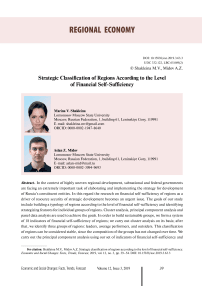Strategic classification of regions according to the level of financial self-sufficiency
Автор: Shakleina Marina V., Midov Aslan Z.
Журнал: Economic and Social Changes: Facts, Trends, Forecast @volnc-esc-en
Рубрика: Regional economy
Статья в выпуске: 3 (63) т.12, 2019 года.
Бесплатный доступ
In the context of highly uneven regional development, subnational and federal governments are facing an extremely important task of elaborating and implementing the strategy for development of Russia's constituent entities. In this regard the research on financial self-sufficiency of regions as a driver of resource security of strategic development becomes an urgent issue. The goals of our study include building a typology of regions according to the level of financial self-sufficiency and identifying strategizing features for individual groups of regions. Cluster analysis, principal component analysis and panel data analysis are used to achieve the goals. In order to build sustainable groups, we form a system of 18 indicators of financial self-sufficiency of regions; we carry out cluster analysis on its basis; after that, we identify three groups of regions: leaders, average performers, and outsiders. This classification of regions can be considered stable, since the composition of the groups has not changed over time. We carry out the principal component analysis using our set of indicators of financial self-sufficiency and identify three generalizing factors that characterize the budgetary security of the regions, the potential of regional and municipal taxes, and the tax burden on the economy. We carry out modeling with the use of panel regression and analyze the influence of each factor on financial self-sufficiency in each group of regions. The resulting classification has significant scientific prospects regarding the formation of a general strategizing methodology for regions with different levels of financial self-sufficiency. The strategic classification can be used by regional authorities to form regional and sectoral development strategies.
Region, strategy, classification, budget security, financial independence, regional development
Короткий адрес: https://sciup.org/147224185
IDR: 147224185 | УДК: 332.122 | DOI: 10.15838/esc.2019.3.63.3
Список литературы Strategic classification of regions according to the level of financial self-sufficiency
- Oates W. An essay on fiscal federalism. Journal of Economic Literature, 1999, no. 37 (3), pp. 1120-1149.
- Bird R.M. Subnational taxation in developing countries: a review of the literature. J. Int. Commerce Econ. Policy, 2011, no. 2, pp. 139-161.
- Martinez-Vazquez J., McNab R. Fiscal decentralization and economic growth. World Development, 2005, no. 31 (9), pp. 1597-1616.
- Oates W. Fiscal Federalism. New York: Harcourt Brace Jovanovich, 1972.
- Thiessen U. Fiscal decentralization and economic growth in high income OECD countries. Fiscal Studies, 2003, no. 24 (3), pp. 237-274.
- Musgrave R.A. The Theory of Public Finance. New York: McGraw-Hill, 1959.
- Brennan G., Buchanan J. The Power to Tax: Analytical Foundations of a Fiscal Constitution. Cambridge: Cambridge University Press, 1980.
- Lockwood B. Fiscal Decentralization: Apolitical Economy Perspective. Warwick Economic Research Papers, 2005. 721 p.
- Gadenne L., Singhal M. Decentralization in developing economies. The Annual Review of Economics, 2014. 581-604 p.
- Prud'homme R. The dangers of decentralization. World Bank Research Observer, 1995, no. 10 (2), pp. 201-220.
- Alexeev M., Mamedov A. Factors determining intra-regional fiscal decentralization in Russia and US. Russian Journal of Economics, 2017, no. 3, pp. 425-444.
- Kvint V.L. Strategicheskoe upravlenie i ekonomika na global'nom formiruyushchemsya rynke . Moscow: Biznes atlas, 2012.
- Igonina L.L. Financial independence of municipalities: limitations and opportunities. Finansy i kredit=Finance and Credit, 2015, no. 35 (659)..
- Methodology for creating a rating of investment attractiveness of regions of Russia by the company RAEKS-Analitika. Available at: https://raexpert.ru/docbank//109/d31/3e8/5564b5d35605a92af9b47c6.pdf..
- Leksin V.N., Shvetsov A.N. Gosudarstvo i regiony: teoriya i praktika gosudarstvennogo regulirovaniya territorial'nogo razvitiya . Moscow: LIBROKOM, 2009. 368 p.
- Ilyshev A.M., Shubat O.M. Multivariate data classification: the features of the technique, the analysis of the practice and prospects of use. Voprosy statistiki=Issues of Statistics, 2010, no. 10, pp. 34-40..
- Repkine A. How similar are the East Asian economies? A cluster analysis perspective on economic cooperation in the region. Journal of International and Area Studies, 2012, vol. 19, no. 1, pp. 27-44.
- Kronthaler F. Economic capability of East German regions: results of a cluster analysis. Regional Studies, 2005, no. 39, pp. 739-750.
- Aivazyan S.A. Metody ekonometriki: ucheb. . Moscow: Magistr. INFRA-M., 2014.
- Kim J.-O., Mueller C.W. Faktornyi analiz: statisticheskie metody i prakticheskie voprosy: sb. rabot . Translated from English under the editorship of I.S. Enyukov. Moscow: Finansy i statistika, 1989.
- Tsyplakov A. Introduction to prediction in classical time series models. Kvantil'=Quantile, 2006, no. 1, p. 3..
- Ratnikova T.A. Introduction to econometric analysis of panel data. Ekonomicheskii zhurnal VShE=Economic Journal of the Higher School of Economics, 2006, vol.10, no. 2, pp. 267-316..
- Magnus Ya.R., Katyshev P.K., Peresetskii A.A. Ekonometrika . Moscow: Delo, 2004.
- Mkhitaryan V.S., Arkhipova M.Yu., Balash V.A., Dubrova T.A., Sirotin V.P. Ekonometrika . Moscow: Prospekt, 2009. 384 p.


